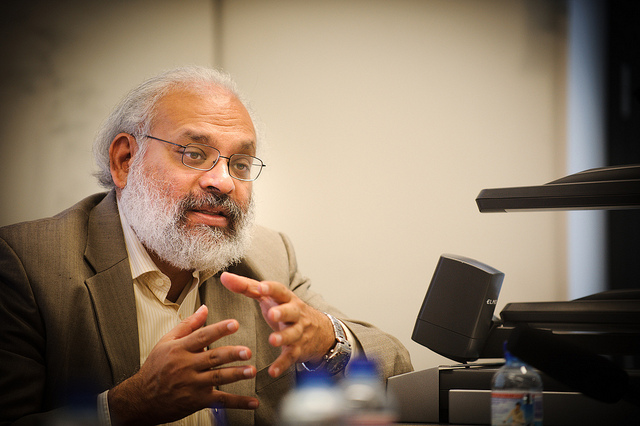Content from the Brookings Institution India Center is now archived. After seven years of an impactful partnership, as of September 11, 2020, Brookings India is now the Centre for Social and Economic Progress, an independent public policy institution based in India.
(Remarks made in the ASSOCHAM Livelihoods Security Summit on November 3, 2014)
Let me begin by expressing my appreciation for ASSOCHAM’s initiatives in furthering debate and understanding on the very critical issue of livelihoods. The theme for this seminar addresses a very important aspect of an overall strategy, i.e. security. Secure livelihoods for all its citizens should indeed be a policy priority for any government. For India, where this goal seems so distant, it is an economic, social and political imperative.
I want to put forward a few facts to provide a backdrop for my approach to the issue of livelihood security. First, about half of the country’s workforce is primarily employed in agriculture, typically an environment with relatively high income volatility and uncertainty. Second, over 90 per cent of the country’s workforce is employed informally, which means that they have not even basic protections, let alone livelihood security. Third, about 40 per cent of the urban workforce is “self-employed”, the majority of these being the entrepreneur, manager and worker all rolled into one, with perhaps a family member working alongside.
All these patterns are indicative of relatively high livelihood insecurity. A policy agenda that emphasizes security must, therefore, benchmark itself on how quickly it is able to change these. We need to shift large numbers of people out of agriculture into relatively more stable employment situations, we need to rapidly increase the share of people employed in the organized sector and we need to give people who are self-employed at tiny scales opportunities to work in larger and less risky organizations.
How do we go about achieving this? An effective strategy for secure livelihoods will need to simultaneously address three components – jobs, skills and safety nets. Let me briefly lay out the key issues in each of these.
On jobs, in terms of the objectives laid out earlier, the key challenge is to create as many jobs as possible in activities outside of agriculture. For many years now, we have been both aspiring to create momentum in manufacturing employment and despairing about our inability to do so. One important step in the right direction is the abolition of job security regulations, which impose an undue cost on the employer – almost like a tax on jobs – which deters rather than encourages job creation. In this context, the recent legislative reforms carried out by the government of Rajasthan are a potential breakthrough. Giving employers flexibility to take on and lay off workers depending on business conditions will, in and of itself, encourage job creation.
Of course, this is not the complete answer. A holistic job creation policy has to address the many and varied factors that increase the costs of doing business and, correspondingly, weaken competitiveness. Increasing capacity and efficiency in infrastructure sectors, reducing the burden of regulatory compliance and, very importantly, removing barriers to inter-state movement of goods through the implementation of a full-fledged Goods and Services Tax (GST) will all contribute to manufacturing competitiveness through cost efficiencies and the full realization of scale economies.
One point I want to flag here is that more flexible hire and fire rules, while they may help to generate new jobs, do not intrinsically contribute to livelihood security. I will return to this point later.
The second component, skills, is also a huge challenge. Jobs may be created, but without adequate numbers of workers with appropriate skills, wage pressures will erode the competitiveness of businesses. The rapid expansion of appropriately skilled people was, and remains, a key policy objective. While the institutional mechanisms set up for this, based on widely distributed franchising of skill development activities, industry involvement in content development, reliable certification and government financial support, is broadly the right way to go, the achievement thus far falls far short of the target.
Further, we must keep in mind that the thrust of skilling programmes, quite legitimately of course, is on job market entrants – young adults just leaving school or soon after. But, in a fast-moving technological environment, skills typically become obsolete in a few years. There is very little livelihood security for people trained in a particular skill, who are displaced every few years by a new generation. From a livelihood security perspective, re-skilling must become a critical component of the skills strategy.
We are not a society that has put much stock on continuing education or re-skilling, but policymakers must start thinking about it very seriously. In any large organization, including government, there is always an emphasis on preparing people for upward mobility through training and orientation programmes. However, these are uncharted waters when it comes to broad-based public programmes, which are required teach already experienced people a relatively new and different set of skills. I believe that the skills dimension of livelihood security must take into account the fact that skilling is not a one-time process; rather, it is a life-cycle process, which must engage with large numbers of people over the 30 or 40 years of their working life.
The third component of the livelihood security framework is a safety net. Earlier, I said that, while more flexible hire-and-fire rules will provide an incentive to employers to hire more workers under a formal contracting arrangement, it is not consistent with security. A formal safety net is, therefore, the other side of the coin as we move ahead with the labour market reform agenda.
The basic problem with permanent employment is that it loads the entire cost of the safety net on to the employer. Effectively, the employer is being asked to provide livelihood security to the worker regardless of business conditions. An economy whose competitive strength is based on the low cost of labour will inevitably find this strength being eroded if the employer is asked to pay the wage plus the entire cost of the safety net. The need for a safety net is unquestionable. What we must do is to find the most efficient way to finance it. Experience suggests that viable safety nets are financed by a combination of contributions from workers, employers and the government.
We already have a safety net in place for rural workers with the explicit objective of livelihood security in the form of the NREGS. It is exclusively funded by the government, which clearly imposes limits on its scale. If we are to expand coverage to workers in manufacturing and services, clearly, public funding will not be enough. We need to start thinking very quickly about putting in place a tripartite safety net, which will complement the increased flexibility in the employment contract without placing an undue burden on individual employers.
Let me conclude by re-emphasizing the proposition that livelihood security must be given a central place in the overall strategy for economic development. The three components of security – jobs, skills and safety nets – need to be addressed simultaneously in order to achieve it meaningfully. In each of these, there are clear signs of forward movement, but other issues, which are not yet in the focus of the policy debate, need to be brought quickly into consideration as well.




